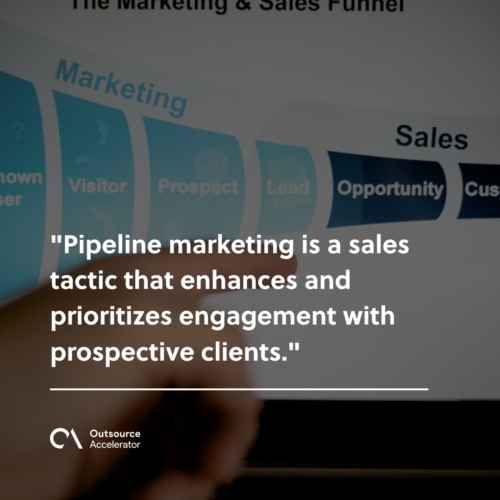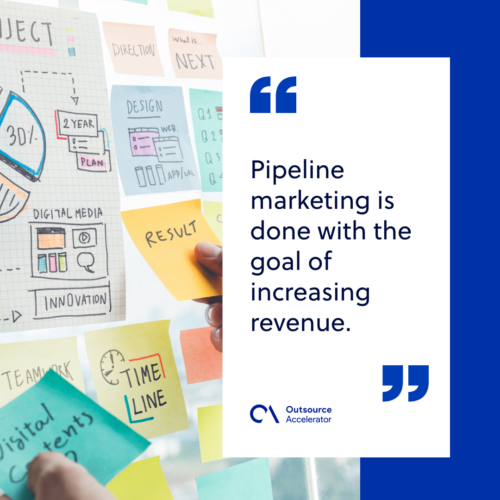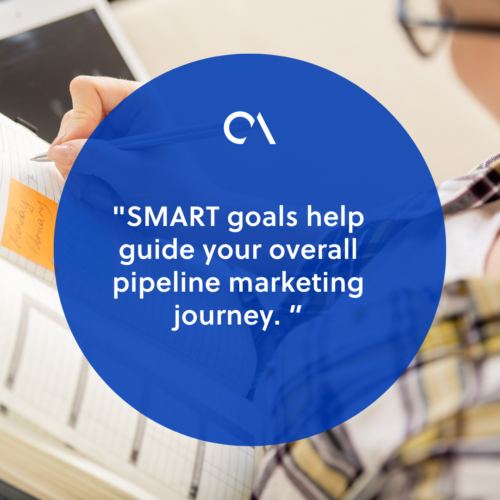Pipeline marketing: A complete guide

After obtaining a significant number of leads, now is the time to narrow down the pipeline further by trying to convert these leads into loyal customers. This process is called pipeline marketing.
This article goes into detail about the process of pipeline marketing and how it can make a difference in your business.
What is pipeline marketing?
Pipeline marketing is a sales tactic that enhances and prioritizes engagement with prospective clients. In other words, it is the process of converting leads into paying customers.
The goal of pipeline marketing is to increase conversion rates, which eventually leads to an increase in revenue.

Pipeline marketing vs. Lead generation
Lead generation is a step in the overall pipeline marketing process as it focuses on creating connections from scratch.
Leads refer to people who have given you their contact information, making them only potential customers. The more people you have from lead generation, the higher your chances of gaining new customers.
Meanwhile, pipeline marketing is about narrowing down those connections to those who have expressed interest in the company and those who haven’t. The goal is to nurture your clients and convert them into loyal customers.
6 stages of pipeline marketing
Pipeline marketing is broken down into various stages. These may vary depending on the company and other external factors.
1. Prospecting
Prospecting is the process of trying to acquire as many leads or potential customers as possible. Think of it like tossing a giant net into the ocean and taking in as many fish as you can.
The essence of prospecting is to widen your potential customer base by getting as many people talking about your brand and expressing interest in buying your product as possible.
Of course, not every person you meet will be interested, which is why you cannot target just anyone. Stick to an appropriate target market, as you are more likely to secure leads from there.
2. Lead generation
Lead generation is finding people or businesses whom you think will be interested in or have already expressed interest in your brand. These people are more likely to be converted into customers.
This stage is where marketers and sales teams develop strategies to gauge the leads’ interest further. What kind of tactics will get the lead to even consider buying the product?
Salespeople can use any kind of sales approach under the sun, including advertising, personalized content, lead magnets, or promotions and sponsorships.
3. Appointment-setting
Once a lead has expressed further interest in your product, this is your opportunity to schedule an appointment with them to introduce the product in person or over a video call.
In this stage, the sales rep will go in-depth about your offering, including demonstrations and how it can be the solution to the customers’ pain points.
4. Extending the offer
After meeting with the prospective customer, it is time to make the final pitch – Why should the customer buy your product/service?
You can explain the different advantages that your brand has over others. You can even offer incentives such as a discount or additional products to sway the customer further.
In this stage, leads also have the chance to negotiate and see what is in it for them.
5. Securing a purchase
If all tactics go well and the lead agrees to a purchase, then congratulations! You can now deliver on the promises and commitments you made to the customer throughout the previous stages.
6. Retention
Even if customers say yes to a purchase, there is no guarantee that they will say yes to the next one. This is where customer retention strategies come in.
Use this time to maintain the relationship with your patrons. This can be done through maintaining open communication, incentives, and special offers to increase their loyalty.
The better your relationship with consumers, the more they will buy your products. They may even put in a good word for you to others.
Benefits of pipeline marketing
Pipeline marketing is an effective strategy that secures long-term customers. Here are some of its benefits:
Full-funnel approach
Pipeline marketing covers the entire sales funnel, which encompasses the full customer journey and does not focus on just lead generation.
A full-funnel approach gives you a clearer understanding of your ideal customer profile, giving you more information about your buyers. This makes it easier for your team to cater offers and marketing campaigns.
Increases sales
Pipeline marketing is done with the goal of increasing revenue. You can achieve this by narrowing your leads down to the most qualified ones until you end up with those who are most willing to exchange money for a product or service.
As a result, you will be able to increase sales in a short amount of time. Not only that, but brands spend less on acquiring leads and instead spend on converting the ones they have.

Gains new customers
As new players in the market, securing customers is a difficult and expensive process, but pipeline marketing helps businesses quickly gain a new following.
This marketing technique allows them to seek out the most qualified leads that will turn out to be a loyal customer base.
How to build a marketing pipeline
Pipeline marketing is easy and full of rewards if you apply the right steps. Here is a quick step-by-step on how you can get started:
1. Identify the target market
You must know exactly who you are selling your products to in order to have a successful marketing pipeline.
The first stage is where you create and define your ideal customer base. Have a clear target market and segment them according to common traits and characteristics.
2. Create a sales pitch or selling strategy
Once you have determined your target audience, you can create marketing campaigns and strategies to raise awareness of your brand.
Your leads will appreciate a customized customer journey. Create a pitch that is tailored to their needs for it to resonate with them.
This is where you must come up with a compelling argument as to why customers must choose your product to solve their problems. Define your advantages and what sets you apart from other companies.
3. Perform outreach
You now have your target market and your sales pitch. The next step is where a little bit of social skills comes in, as you now must perform outreach.
Using the information you gained from defining your target market, find the most relevant companies or individuals who match your description the best. Do not waste time on maybe’s or irrelevant contacts.
There are many different channels where you can do outreach, such as personalized emails, social media, or networking events. You can use a combination of inbound and outbound sales techniques to attract buyers to your brand.
4. Schedule appointments
Once you have reached out and acquired a list of people who have shown interest in your brand, the next step is to move them further down the sales funnel by scheduling appointments.
This is your opportunity to explain or demonstrate your product or service further. Additionally, this step allows you to go over the next steps of the funnel with your customer.
Apart from further convincing the buyer, use this time to present them with a customized solution. You may opt for personalized offers or anything that will improve their time with your brand.
Doing so helps build trust between you and the customer and establishes your credibility as a legitimate seller.
5. Negotiate
Of course, not every customer will be willing to push through with your offer. Some may even drop out of the sales funnel and move on or try to negotiate better terms.
As a seller, it is crucial to be accommodating and open to feedback and suggestions in order to retain your customers. Listen to what they have to say and be flexible if they do not agree with your proposition.
6. Follow up
After the initial meeting, remember to maintain communication with your customers. Be open to any additional questions or concerns, and remind them that they may contact you anytime.
If all goes well, the customer may continue engaging with your brand and buying your products, eventually establishing loyalty and retention.
If a customer decides not to pursue your brand, do not take it against them and remain professional. Remember to show appreciation for their time and that they are welcome to come back.
Pipeline marketing tips to remember
Pipeline marketing can be tricky as there are a lot of factors to consider. Keep these quick tips in mind in order for things to go smoothly.
Remove unqualified leads
Do not waste time on unqualified leads and uninterested customers, as they will only be turned away further if you continue to pester them. Maintain professionalism and move on to other prospects.
Remain flexible
A lot can go wrong in pipeline marketing. A huge chunk of your qualified leads may have churned, or one of your marketing tactics may not be going as planned.
It is important to remain level-headed and analyze the situation rationally. Be open to unwanted changes and adjust accordingly.
Set SMART goals
SMART goals help guide your overall pipeline marketing journey. Make sure your goals are specific, measurable, attainable, relevant, and time-bound.
These ensure that your pipeline marketing efforts are purposeful, measurable, and aligned with your overall business strategy.

Mastering pipeline marketing to boost sales
Pipeline marketing requires a lot of research, analysis, and communication between parties. You can only succeed in pipeline marketing by creating and following a strong game plan and remaining flexible.
If you’re seeking professional assistance, Outsourced’s sales consultants may be able to help.
This type of marketing may be difficult, but it is rewarding and helps secure the necessary revenue your business needs to stay competitive.







 Independent
Independent




